Impact of the Electric Mobility Implementation on the Greenhouse Gases Production in Central European Countries
Abstract
1. Introduction
2. Data, Methods, and Initial Calculations
2.1. Energy Production
- (1)
- the composition of primary energy sources,
- (2)
- the effectiveness of the individual sources used,
- (3)
- the effectiveness of the transmission and distribution of the electricity.
| η | final energy effectiveness (-) |
| ηProd | effectiveness of electric power (-) |
| ηTrans | effectiveness of transmission (-) |
| ηVeh | effectiveness of vehicle system (-) |
| ηSi | effectiveness of a particular primary source (-) |
| pSi | share of a particular primary source (-) |
| pS | sum of partial shares of individual sources (-) |
2.2. Emissions Production
- (1)
- changes in the ratio of primary sources used in electricity generation,
- (2)
- estimated changes in the efficiency of electric power generation from all sources,
- (3)
- the effectiveness of the transmission and distribution of electric power in each country.
3. Results Regarding the Energy Consumption and the GHG Production of Electric Vehicles
4. Discussion
5. Conclusions
Author Contributions
Funding
Acknowledgments
Conflicts of Interest
References
- Knez, M.; Matjaz, K.; Tariq, M.; Jereb, B.; Cullinane, K. The estimation of a driving cycle for Celje and a comparison to other European cities. Sustain. Cities Soc. 2014, 11, 56–60. [Google Scholar] [CrossRef]
- Sarkan, B.; Caban, J.; Marczuk, A.; Vrabel, J.; Gnap, J. Composition of exhaust gases of spark ignition engines under conditions of periodic inspection of vehicles in Slovakia. Przem. Chem. 2017, 96, 675–680. [Google Scholar]
- Yang, L.; Wang, Y.; Han, S.; Liu, Y. Urban transport carbon dioxide (CO2) emissions by commuters in rapidly developing Cities: The comparative study of Beijing and Xi’an in China. Transp. Environ. 2019, 68, 65–83. [Google Scholar] [CrossRef]
- Petro, F.; Konecny, V. Calculation of emissions from transport services and their use for the internalisation of external costs in road transport. Proc. Eng. 2017, 192, 677–682. [Google Scholar] [CrossRef]
- Lebkowski, A. Studies of Energy Consumption by a City Bus Powered by a Hybrid Energy Storage System in Variable Road Conditions. Energies 2019, 12, 951. [Google Scholar] [CrossRef]
- Lizbetin, J.; Hlatka, M.; Bartuska, L. Issues concerning declared energy consumption and greenhouse gas emissions of FAME biofuels. Sustainability 2018, 10, 3025. [Google Scholar] [CrossRef]
- Zhang, L.W.; Yang, Y.; Sun, M.H.; Liu, H. Energy management strategy based on dynamic programming for dual source trolleybus. Teh. Vjesn. Tech. Gaz. 2017, 24, 1439–1447. [Google Scholar]
- European Commission. 2020 Climate & Energy Package. Available online: https://ec.europa.eu/clima/policies/strategies/2020_en (accessed on 19 May 2018).
- Lodi, C.; Seitsonen, A.; Paffumi, E.; Gennaro, M.; Huld, T.; Malfettani, S. Reducing CO2 Emissions of Conventional Fuel Cars by Vehiclephotovoltaic Roofs. 2018. Available online: https://reader.elsevier.com/reader/sd/06B97658021746555534D41EB2E86B290AA (accessed on 18 May 2018).
- Erixon, F. The Europe 2020 Strategy: Time for Europe to Think Again. 2010. Available online: http://journals.sagepub.com/doi/full/10.1007/s12290-010-0120-8 (accessed on 18 May 2018).
- European Commission. 2030 Climate & Energy Framework. Available online: https://ec.europa.eu/clima/policies/strategies/2030_en (accessed on 18 May 2018).
- Rohrer, J. Time for Change: CO2-the Major Cause of Global Warming. 2007. Available online: https://timeforchange.org/CO2-cause-of-global-warming (accessed on 18 May 2018).
- European Commission. 2050 Low-Carbon Economy. Available online: https://ec.europa.eu/clima/policies/strategies/2050_en (accessed on 18 May 2018).
- Bukova, B.; Brumercikova, E.; Kondek, P. Determinants of the EU transport market. In Proceedings of the 2016 International Conference on Engineering Science and Management, Zhengzhou, China, 13–14 August 2016; pp. 249–252. [Google Scholar]
- Ondrus, J.; Karon, G. Video System as a Psychological Aspect of Traffic Safety Increase. In Proceedings of the 17th International Conference on Transport Systems Telematics (TST), Katowice, Poland, 5–8 April 2017; pp. 167–177. [Google Scholar]
- European Commission. Transport: EU Transport White Paper. Available online: https://ec.europa.eu/clima/policies/international/paris_protocol/transport_en (accessed on 19 May 2018).
- Bogale, B.D. Handbook of Research on Sustainable Development and Governance Strategies for Economic Growth in Africa; ICI Global Disseminator of Knowledge: Pennsylvania, PA, USA, 2018; pp. 416–442. [Google Scholar]
- Gasparik, J.; Siroky, J.; Peceny, L.; Halas, M. Methodology for assessing the quality of rail connections on the network. Komunikacie 2014, 16, 25–30. [Google Scholar]
- Gogola, M. The analysis of traffic impact on urban environment in city of Zilina. Log. Sci. J. Trans. Log. 2010, 1, 44–52. [Google Scholar]
- Schröder, S.; Liedtke, G.T. Towards an integrated multi-agent urban transport model of passenger and freight. Res. Transp. Econ. 2017, 64, 3–12. [Google Scholar] [CrossRef]
- Žaglinskis, J.; Rapalis, P.; Lazareva, N. An overview of Natural Gas Use in Ships: Necessity and Engine Supply. Period. Polytech. Transp. Eng. 2018, 46, 185–193. [Google Scholar] [CrossRef]
- Alam, M.S.; Hyde, B.; Duffy, P.; McNabola, A. Analysing the Co-Benefits of transport fleet and fuel policies in reducing PM2.5 and CO2 emissions. J. Clean. Product 2018, 172, 623–634. [Google Scholar] [CrossRef]
- Hlatka, M.; Bartuska, L. Comparing the Calculations of Energy Consumption and Greenhouse Gases Emissions of Passenger Transport Service. Nase More 2018, 65, 224–229. [Google Scholar] [CrossRef]
- Jurkovic, M.; Kalina, T.; Teixeira, A.F. Possibilities of using alternative fuels for transport solution in Brazil. In Proceedings of the 21st International Scientific Conference TRANSPORT MEANS 2017, Kaunas, Lithuania, 20–22 September 2017; pp. 724–728. [Google Scholar]
- Milojevic, S. Sustainable application of natural gas as engine fuel in city buses—Benefit and restrictions. J. Appl. Eng. Sci. 2017, 15, 81–88. [Google Scholar] [CrossRef]
- Mintzia, D.; Kehagia, F.; Tsakalidis, A.; Zervas, E. A methodological framework for the comparative analysis of the environmental performance of roadway and railway transport. Promet Traffic Transp. 2018, 30, 721–731. [Google Scholar] [CrossRef]
- Moro, A.; Lonza, L. Electricity carbon intensity in European Member States: Impacts on GHG emissions of electric vehicles. Transp. Res. Part D 2018, 64, 5–14. [Google Scholar] [CrossRef]
- Pawełczyk, M.; Szumska, E. Evaluation of the efficiency of hybrid drive applications in urban transport system on the example of a medium size city. In Proceedings of the 13th International Conference on Modern Electrified Transport, MET 2017, Warsaw, Poland, 5–7 October 2017. [Google Scholar]
- Milojevic, S.; Milojević, S.; Skrucany, T.; Milošević, H.; Stanojević, D.; Pantić, M.; Stojanović, B. Alternative drive systems and environmentally friendly public passengers transport. Appl. Eng. Lett. 2018, 3, 105–113. [Google Scholar] [CrossRef]
- Austriatech. 2019. Available online: https://www.austriatech.at/en/news/electromobility-with-expertise (accessed on 8 February 2019).
- Babić, D.; Bajor, I.; Babić, M.I. Choice factors of distribution channels. J. Transp. Logist. 2010, 1, 5–13. [Google Scholar]
- Hoerstebrock, T.; Hahn, A.; Sauer, J. Tool based assessment of electromobility in urban logistics. Stud. Comput. Intell. 2014, 537, 379–395. [Google Scholar]
- Carbon, C.C.; Gebauer, F. The Safe-Range-Inventory (SRI): An assistance tool for optimizing the charging infrastructure for electric vehicles. Traffic Psychol. Behav. 2017, 47, 101–113. [Google Scholar] [CrossRef]
- Harrison, G.; Thiel, C. An exploratory policy analysis of electric vehicle sales competition and sensitivity to infrastructure in Europe. Technol. Forecast. Soc. Chang. 2017, 114, 165–178. [Google Scholar] [CrossRef]
- Plötz, P.; Gnann, T.; Sprei, F. Can policy measures foster plug-in electric vehicle market diffusion? In Proceedings of the EVS 2016—9th International Electric Vehicle Symposium 2016, Montreal, QC, Canada, 19–22 June 2016. [Google Scholar]
- Seixas, J.; Simões, S.; Dias, L.; Kanudia, A.; Fortes, P.; Gargiulo, M. Assessing the cost-effectiveness of electric vehicles in European countries using integrated modeling. Energy Policy 2015, 80, 165–176. [Google Scholar] [CrossRef]
- Zubaryeva, A.; Thiel, C.; Barbone, E.; Mercier, A. Assessing factors for the identification of potential lead markets for electrified vehicles in Europe: Expert opinion elicitation. Technol. Forecast. Soc. Chang. 2012, 79, 1622–1637. [Google Scholar] [CrossRef]
- Electric Cars Exceed 1m in Europe as Sales Soar by More Than 40%. The Guardian 2018. Available online: https://www.theguardian.com/environment/2018/aug/26/electric-cars-exceed-1m-in-europe-as-sales-soar-by-more-than-40-per-cent (accessed on 13 February 2019).
- Cobb, J. The World Just Bought Its Two-Millionth Plug-in Car. 2017. Available online: https://www.hybridcars.com/the-world-just-bought-its-two-millionth-plug-in-car/ (accessed on 10 December 2018).
- Rievaj, V.; Synak, F. Does electric car produce emissions? Sci. J. Sil. Univ. Technol. Ser. Transp. 2017, 94, 187–197. [Google Scholar] [CrossRef]
- Li, S.; Li, J.; Li, N.; Gao, Y. Vehicle Cycle Analysis Comparison of Battery Electric Vehicle and Conventional Vehicle in China. In Proceedings of the International Powertrains, Fuels and Lubricants Meeting, FFL 2013, Seoul, Korea, 21–23 October 2013. [Google Scholar]
- Moro, A.; Helmers, E. A new hybrid method for reducing the gap between WTW and LCA in the carbon footprint assessment of electric vehicles. Int. J. Life Cycle Assess. 2017, 22, 4–14. [Google Scholar] [CrossRef]
- Pero, F.D.; Delogu, M.; Pierini, M. Life Cycle Assessment in the Automotive Sector: A Comparative Case Study of Internal Combustion Engine (ICE) and Electric Car. In Proceedings of the 47th International Conference on Stress Analysis, AIAS 2018, Villa San Giovanni, Italy, 5–8 September 2018; pp. 521–537. [Google Scholar]
- Saenz-Esteruelas, J.; Figliozzi, M.; Serrano, A.; Faulin, J. Electrifying last-mile deliveries: A carbon footprint comparison between internal combustion engine and electric vehicles. In Proceedings of the 1st International Conference on Smart Cities, Smart-CT 2016, Malaga, Spain, 15–17 June 2016; pp. 76–84. [Google Scholar]
- Ahn, S.W. EU member-states’ reaction to the climate change in transportation: French case of the development of electric vehicles. J. Contemp. Eur. Stud. 2019, 37, 103–127. [Google Scholar]
- Astegiano, P.; Fermi, F.; Martino, A. Investigating the impact of e-bikes on modal share and greenhouse emissions: A system dynamic approach. In Proceedings of the 21st Euro Working Group on Transportation Meeting (EWGT 2018). Transp. Res. Procedia 2019, 37, 163–170. [Google Scholar] [CrossRef]
- Lu, M.J.; Taiebat, M.; Xu, M.; Hsu, S.C. Multiagent spatial simulation of autonomous taxis for urban commute: Travel economics and environmental impacts. J. Urban Plan. Dev. 2018, 144, 04018033. [Google Scholar] [CrossRef]
- Biresselioglu, M.E.; Kaplan, M.D.; Yilmaz, B.K. Electric mobility in Europe: A comprehensive review of motivators and barriers in decision making processes. Transp. Res. Part A-Policy Pract. 2018, 109, 1–13. [Google Scholar] [CrossRef]
- Plötz, P.; Gnann, T.; Jochem, P.; Yilmaz, H.U.; Kaschub, T. Impact of electric trucks powered by overhead lines on the European electricity system and CO2 emissions. Energy Policy 2019, 130, 32–40. [Google Scholar] [CrossRef]
- Blyankinshtein, I.; Askhabov, A.; Voevodin, E.; Kashura, A.; Malchikov, S. Concept and models for evaluation of black and white smoke components in diesel engine exhaust. Transp. Probl. 2017, 12, 83–91. [Google Scholar]
- Mukherjee, D.; Rajvanshi, A. Application of Strategic Environmental Assessment as a Land Use Planning Tool in India: A Case of Gurgaon-Manesar Development Plan, Haryana, India. J. Environ. Assess. Policy Manag. 2016, 18, 1650017. [Google Scholar] [CrossRef]
- Stoilova, S. Study of the efficiency of motorail trains as a factor in transport development. In Proceedings of the 3rd International Multidisciplinary Scientific Conference on Social Sciences and Arts SGEM 2016, Albena, Bulgaria, 22–31 August 2016; pp. 627–634. [Google Scholar]
- Methodology for Calculation and Declaration of energy Consumption and GHG Emissions of Transport Services (Freight and Passengers); European Standard EN 16 258:2012; European Association for Forwarding, Transport, Logistics and Customs Services (CLECAT): Bruxelles, Belgium, 2012.
- European Commission. Technical Annex to the SEAP Template Instructions Document: The Emission Factors; The European Commission: Bruxelles, Belgium, 2012. [Google Scholar]
- Skrúcaný, T.; Milojević, S.; Semanová, Š.; Čechovič, T.; Figlus, T.; Synák, F. The Energy Efficiency of Electric Energy as a Traction Used in Transport. Transp. Tech. Technol. 2018, 14, 9–14. [Google Scholar] [CrossRef]
- European Commission. DG ENER, Unit A4, Energy Datasheets: EU28 Countries. 2018. Available online: https://ec.europa.eu/energy/en/data/energy-statistical-pocketbook (accessed on 20 January 2019).
- IAEA Bulletin. Changing realities. Int. At. Energy Agency 1998, 1, 3. [Google Scholar]
- Slovak Ministry of the Economy. Decree No. 88/2015 of the Ministry of Economy of the Slovak Republic. Laying Down the Scope of Evaluation, Method of Calculation and Value of Energy Efficiency of Sources and Distribution; Slovak Ministry of the Economy: Bratislava, Slovakia, 2015.
- Electropedia—Battery and Energy Technologies—Energy Efficiency. 2019. Available online: https://www.mpoweruk.com (accessed on 20 January 2019).
- Decarbonisation Pathways, Publication of Eurelectric (Iniciative of Energy Industry in Europe). 2018. Available online: https://cdn.eurelectric.org/media/3457/decarbonisation-pathways-h-5A25D8D1.pdf (accessed on 15 December 2018).
- European Reference Life Cycle Database. 2012. Available online: http://lca.jrc.ec.europa.eu/lcainfohub/datasetArea.vm (accessed on 20 January 2019).
- Covenant of Mayors. Reporting Guidelines on Sustainable Energy Action Plan and Monitoring, Version 1.0; European Commission: Bruxelles, Belgium, 2014. [Google Scholar]
- Spritmonitor.de. Verbrauchswerte Real Erfahren. Available online: https://www.spritmonitor.de (accessed on 12 February 2019).
- Skrúcaný, T.; Semanová, Š.; Figlus, T.; Šarkan, B.; Gnap, J. Energy intensity and GHG production of chosen propulsions used in road transport. Communications 2017, 19, 3–9. [Google Scholar]
- Global EV Outlook. Scaling Up the Transition to Electric Mobility. 2019. Available online: https://www.iea.org/publications/reports/globalevoutlook2019/ (accessed on 5 September 2019).
- Publications Office of the EU. EU Energy in Figures. Statisticalpocketbook 2018; Office of the European Union: Luxemburg, 2018. [Google Scholar]
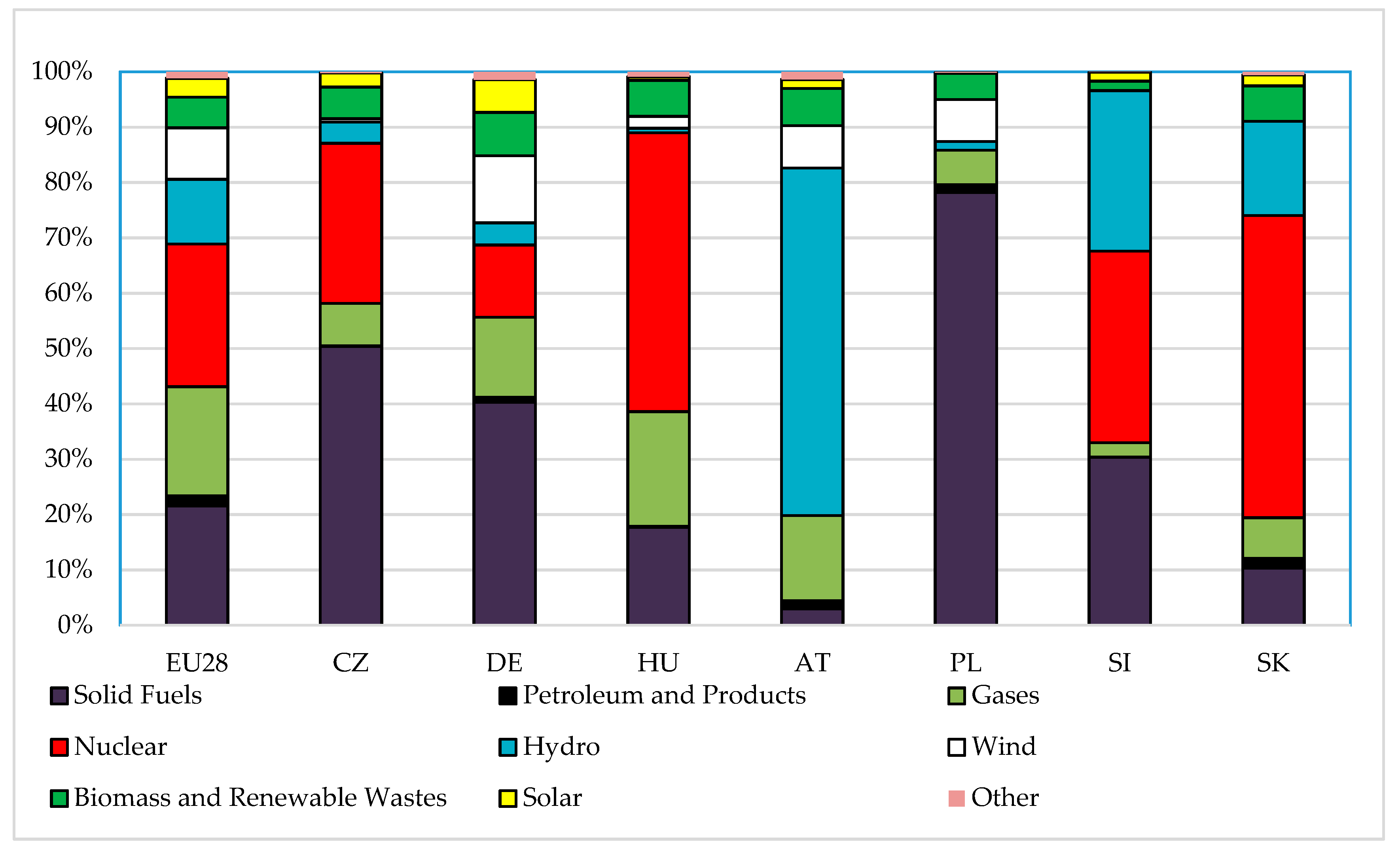
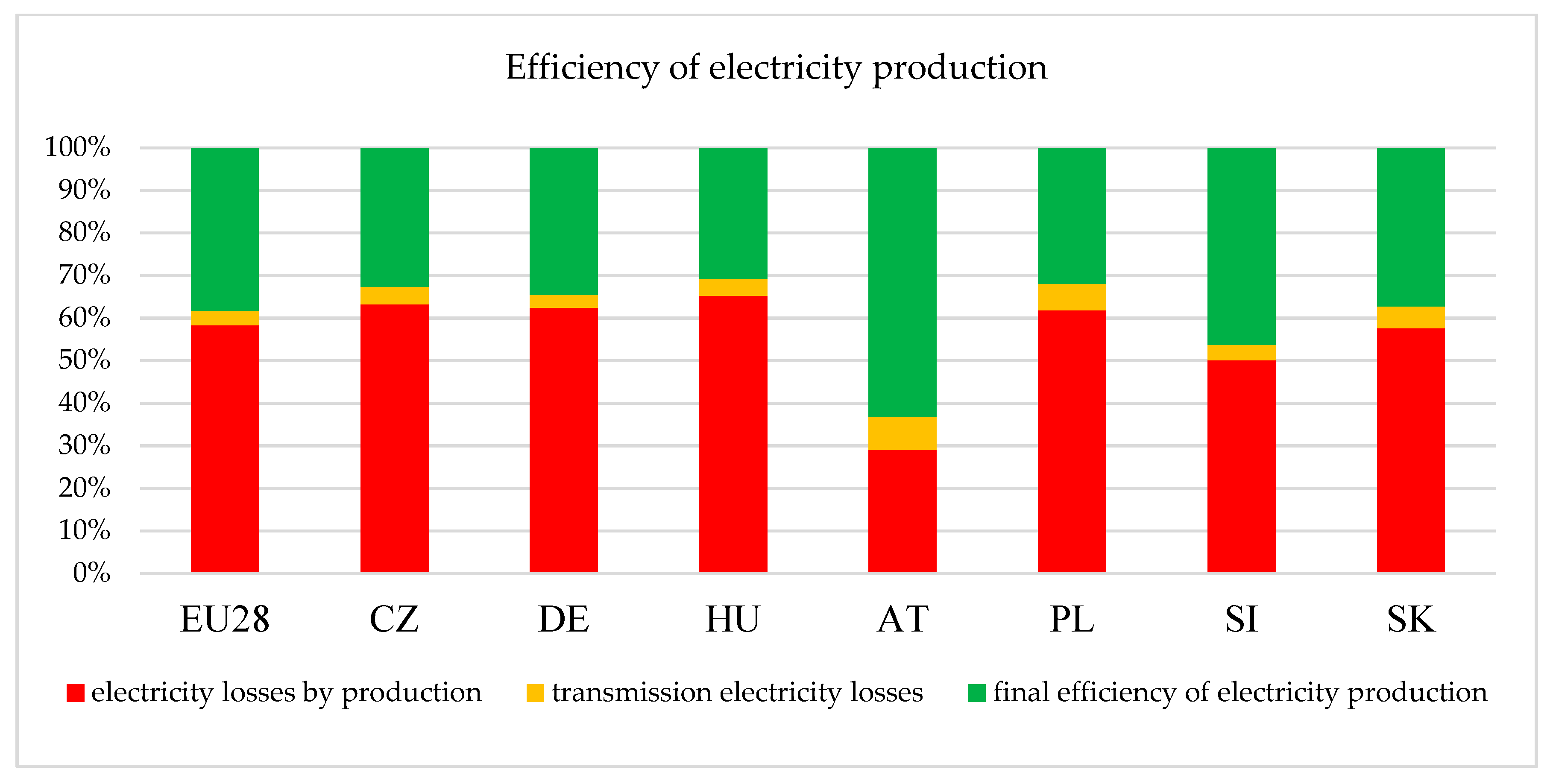
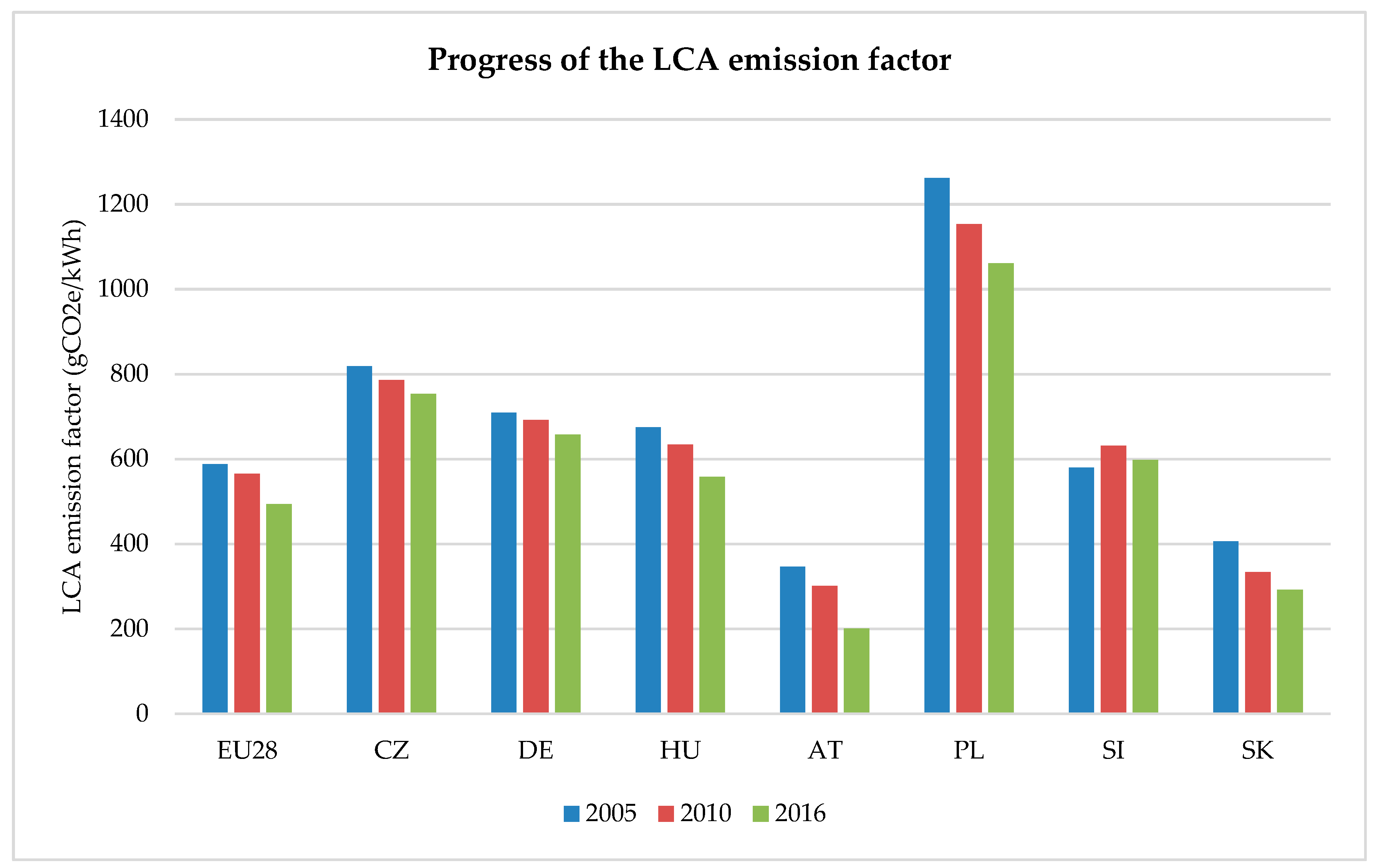
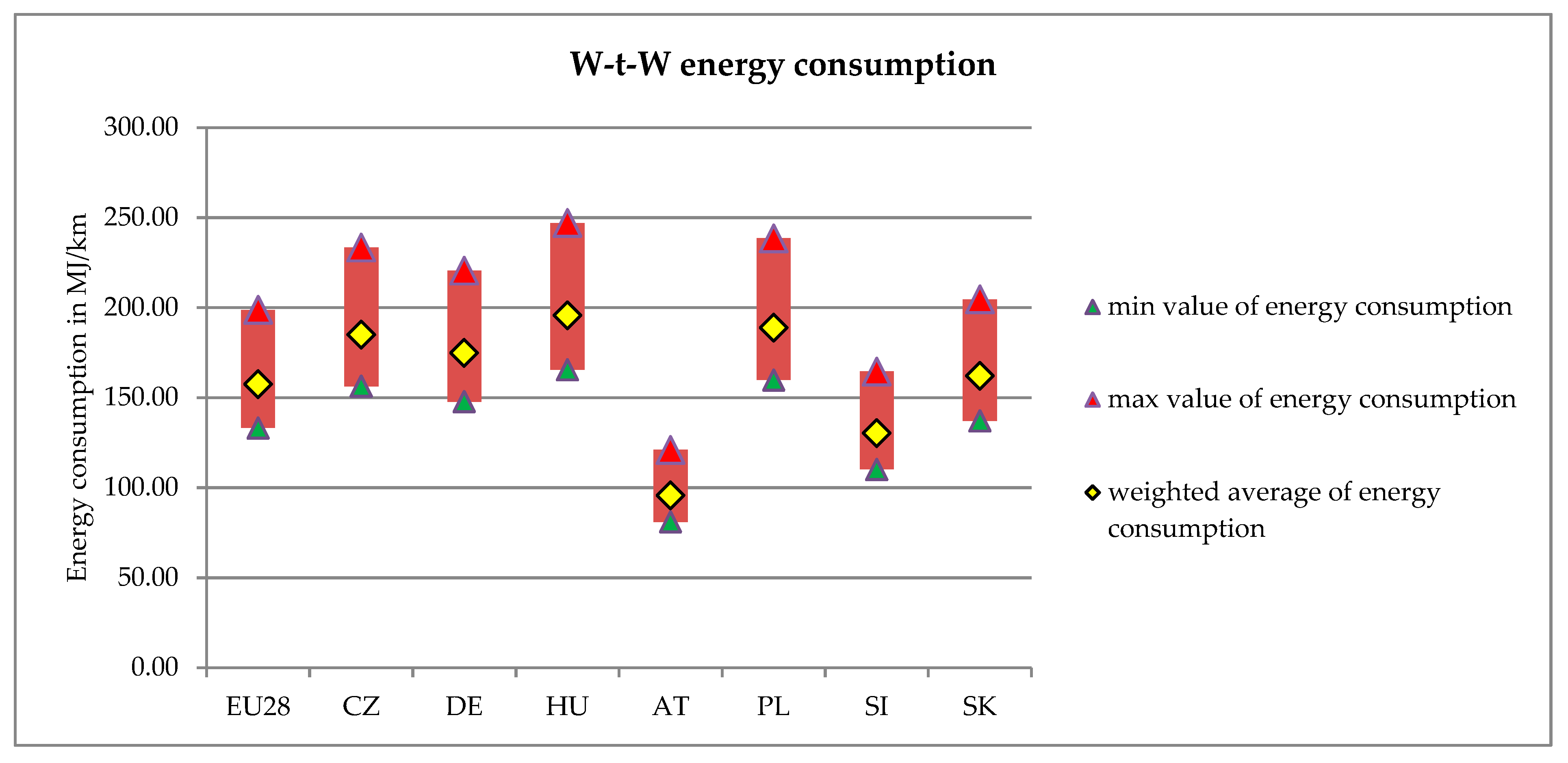
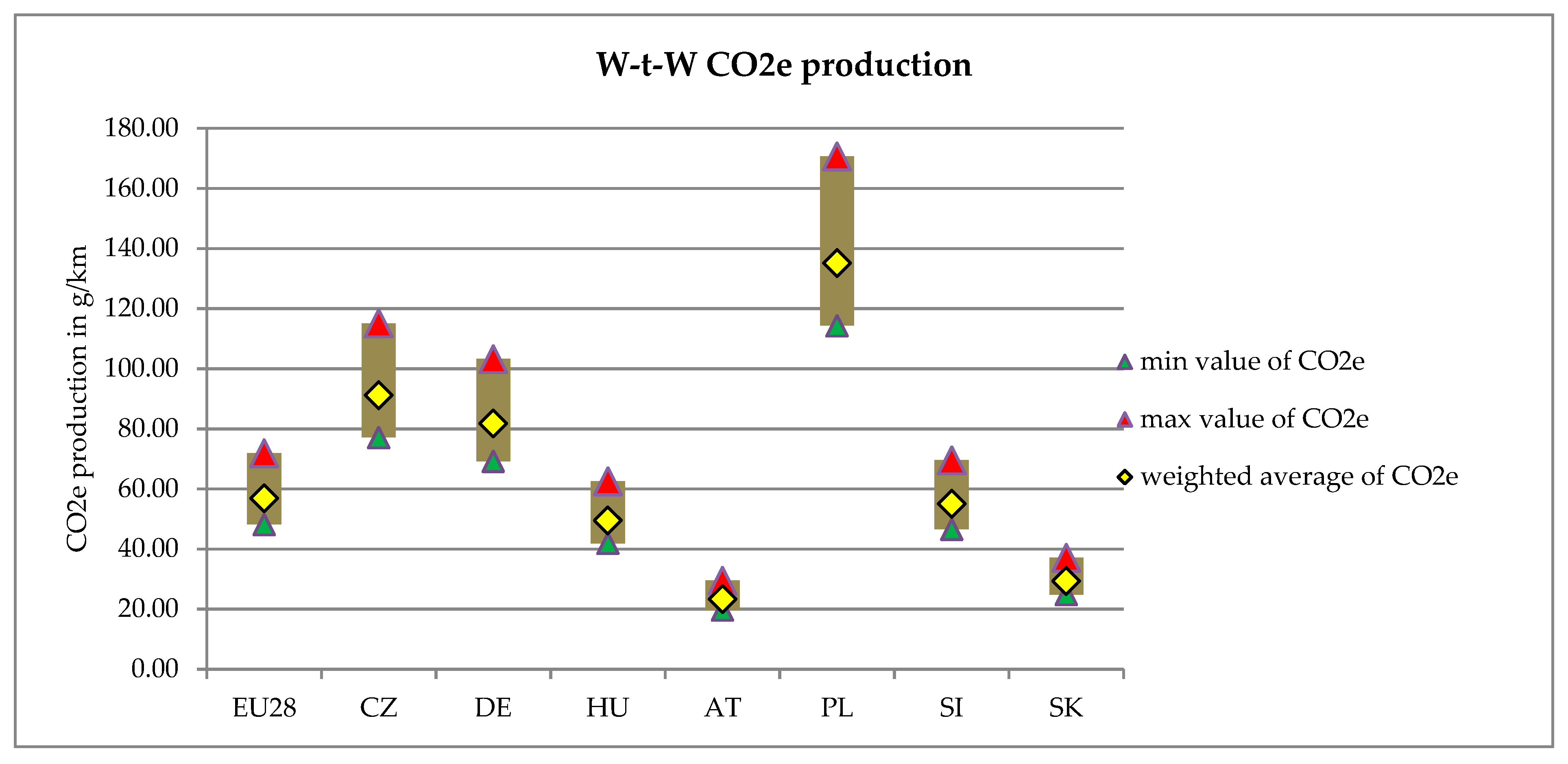
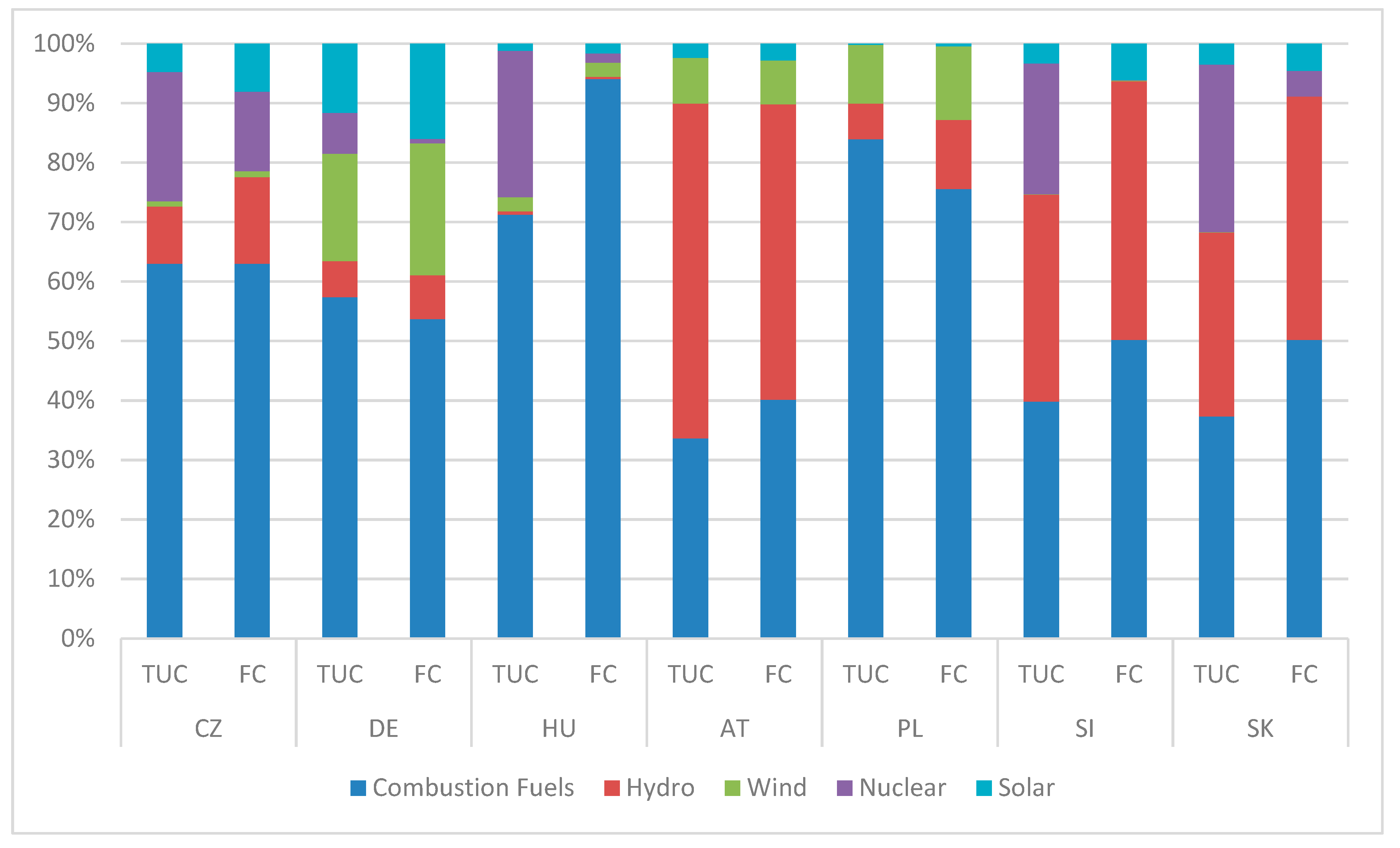
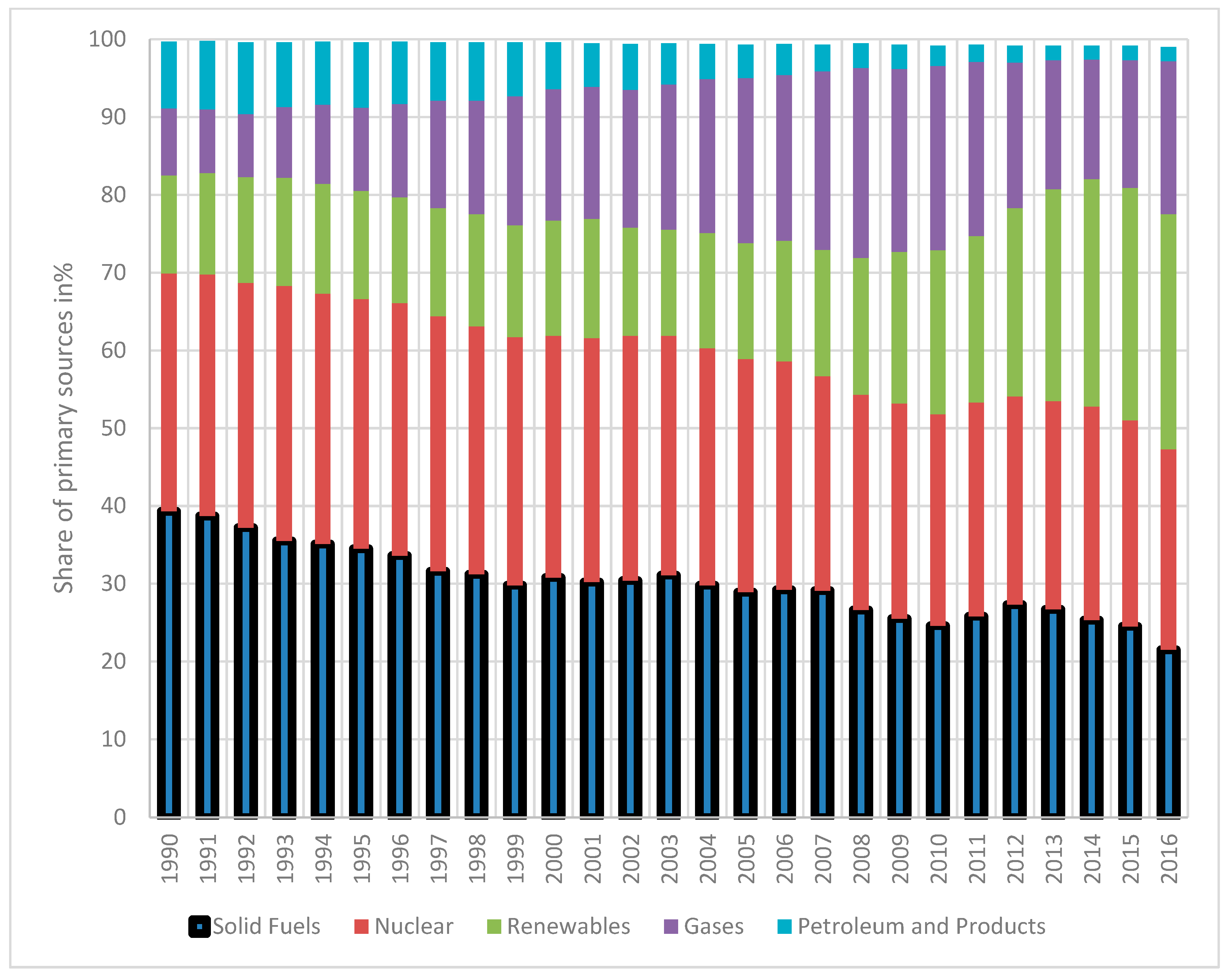
| Electricity Producing Device | Fuel | Electric Power | Year of Introducing the Plant | ||
|---|---|---|---|---|---|
| before 1998 | 1998–2012 | 2013–2015 | |||
| (MW) | Efficiency (%) | ||||
| Combustion device and condensing steam turbine | black coal | to 15 | 36 | 36 | 38 |
| from 15 incl. to 50 | 38 | 38 | 40 | ||
| 50 and higher | 39 | 39 | 41 | ||
| brown coal | to 15 | 35 | 35 | 37 | |
| from 15 incl. to 50 | 37 | 37 | 39 | ||
| 50 and higher | 38 | 38 | 40 | ||
| natural gas | to 10 | 38 | 38 | 40 | |
| from 10 incl. to 35 | 40 | 40 | 42 | ||
| 35 and higher | 41 | 41 | 43 | ||
| heavy fuel oil | to 15 | 36 | 36 | 38 | |
| from 15 incl. to 50 | 38 | 38 | 40 | ||
| 50 and higher | 39 | 39 | 41 | ||
| Heat source and condensing steam turbine | nuclear | to 500 | 31 | 31 | 32 |
| from 500 incl. to 1000 | 31 | 31 | 32 | ||
| 1000 and higher | 31 | 31 | 32 | ||
| heat from industrial processes | to 10 | 36 | 36 | 36 | |
| from 10 incl. to 35 | 36 | 36 | 36 | ||
| 35 and higher | 36 | 36 | 36 | ||
| ICE | Natural gas | to 0.05 | 29 | 29 | 29 |
| Output | Direct Energy Consumption (MJ) | Direct Energy Consumption (kWh) | Country | Overall Energy Consumption (W-t-W) (kWh) |
|---|---|---|---|---|
| Electricity | 100 | 28 | EU28 | 72.9 |
| CZ | 85.7 | |||
| DE | 80.9 | |||
| HU | 90.7 | |||
| AT | 44.4 | |||
| PL | 87.5 | |||
| SI | 60.4 | |||
| SK | 75.0 |
| LCA Emission Factor (gCO2e/kWh) | ||||||||
|---|---|---|---|---|---|---|---|---|
| Year | EU28 | CZ | DE | HU | AT | PL | SI | SK |
| 2005 | 588 | 819 | 709 | 675 | 346 | 1262 | 580 | 406 |
| 2010 | 565 | 786 | 692 | 634 | 301 | 1153 | 631 | 334 |
| 2016 | 494 | 754 | 657 | 558 | 200 | 1061 | 598 | 292 |
| Vehicle Drive | Country | Ø Energy Consumption (kWh/100km) | T-t-W | W-t-W | |||
|---|---|---|---|---|---|---|---|
| Energy Consumption (MJ/km) | Energy Consumption (kWh/km) | Production of CO2e (g/km) | Energy Consumption (MJ/km) | Production of CO2e (g/km) | |||
| Electric | EU28 | 14.2 | 51.12 | 0.142 | 0 | 133.12 | 48.14 |
| 16.8 | 60.48 | 0.168 | 157.50 | 56.95 | |||
| 21.2 | 76.32 | 0.212 | 198.75 | 71.87 | |||
| CZ | 14.2 | 51.12 | 0.142 | 156.33 | 77.11 | ||
| 16.8 | 60.48 | 0.168 | 184.95 | 91.22 | |||
| 21.2 | 76.32 | 0.212 | 233.39 | 115.12 | |||
| DE | 14.2 | 51.12 | 0.142 | 147.75 | 69.15 | ||
| 16.8 | 60.48 | 0.168 | 174.80 | 81.82 | |||
| 21.2 | 76.32 | 0.212 | 220.58 | 103.24 | |||
| HU | 14.2 | 51.12 | 0.142 | 165.44 | 41.89 | ||
| 16.8 | 60.48 | 0.168 | 195.73 | 49.56 | |||
| 21.2 | 76.32 | 0.212 | 246.99 | 62.54 | |||
| AT | 14.2 | 51.12 | 0.142 | 81.01 | 19.74 | ||
| 16.8 | 60.48 | 0.168 | 95.85 | 23.35 | |||
| 21.2 | 76.32 | 0.212 | 120.95 | 29.47 | |||
| PL | 14.2 | 51.12 | 0.142 | 159.75 | 114.31 | ||
| 16.8 | 60.48 | 0.168 | 189.00 | 135.24 | |||
| 21.2 | 76.32 | 0.212 | 238.50 | 170.66 | |||
| SI | 14.2 | 51.12 | 0.142 | 110.17 | 46.58 | ||
| 16.8 | 60.48 | 0.168 | 130.34 | 55.10 | |||
| 21.2 | 76.32 | 0.212 | 164.48 | 69.54 | |||
| SK | 14.2 | 51.12 | 0.142 | 137.05 | 24.85 | ||
| 16.8 | 60.48 | 0.168 | 162.14 | 29.40 | |||
| 21.2 | 76.32 | 0.212 | 204.61 | 37.10 | |||
| Energy Source | FC and FE (l, kg, kWh/100km) | W-t-W | |
|---|---|---|---|
| Energy Consumption (MJ/100km) | Production CO2e (g/km) | ||
| Gasoline | 5.6 | 211 | 161 |
| CNG | 4.4 | 220 | 135 |
| Diesel | 4.4 | 188 | 143 |
| electricity * | 20 | 114-233 | 28-161 |
| hybrid ** | 4 | 151 | 115 |
© 2019 by the authors. Licensee MDPI, Basel, Switzerland. This article is an open access article distributed under the terms and conditions of the Creative Commons Attribution (CC BY) license (http://creativecommons.org/licenses/by/4.0/).
Share and Cite
Skrúcaný, T.; Kendra, M.; Stopka, O.; Milojević, S.; Figlus, T.; Csiszár, C. Impact of the Electric Mobility Implementation on the Greenhouse Gases Production in Central European Countries. Sustainability 2019, 11, 4948. https://doi.org/10.3390/su11184948
Skrúcaný T, Kendra M, Stopka O, Milojević S, Figlus T, Csiszár C. Impact of the Electric Mobility Implementation on the Greenhouse Gases Production in Central European Countries. Sustainability. 2019; 11(18):4948. https://doi.org/10.3390/su11184948
Chicago/Turabian StyleSkrúcaný, Tomáš, Martin Kendra, Ondrej Stopka, Saša Milojević, Tomasz Figlus, and Csaba Csiszár. 2019. "Impact of the Electric Mobility Implementation on the Greenhouse Gases Production in Central European Countries" Sustainability 11, no. 18: 4948. https://doi.org/10.3390/su11184948
APA StyleSkrúcaný, T., Kendra, M., Stopka, O., Milojević, S., Figlus, T., & Csiszár, C. (2019). Impact of the Electric Mobility Implementation on the Greenhouse Gases Production in Central European Countries. Sustainability, 11(18), 4948. https://doi.org/10.3390/su11184948








